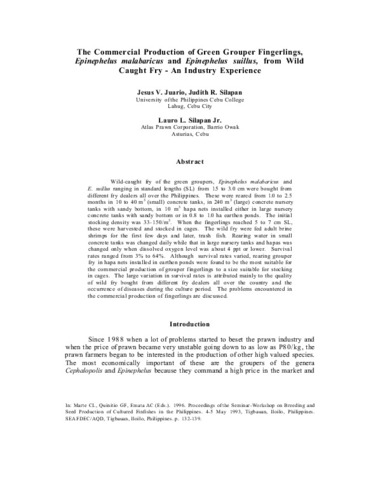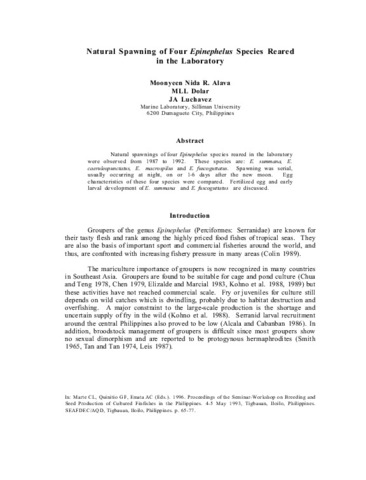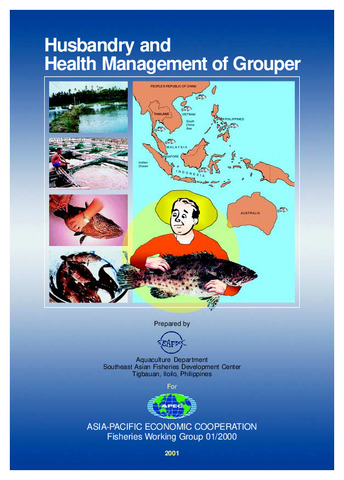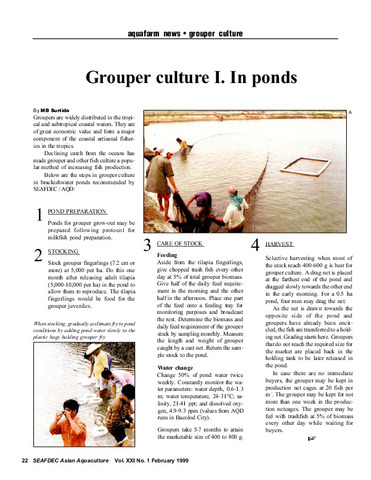The commercial production of green grouper fingerlings, Epinephelus suillus, from wild caught fry - an industry experience
Share
Abstract
Wild-caught fry of the green groupers, Epinephelus malabaricus and E. suillus ranging in standard lengths (SL) from 1.5 to 3.0 cm were bought from different fry dealers all over the Philippines. These were reared from 1.0 to 2.5 months in 10 to 40 m3 (small) concrete tanks, in 240 m3 (large) concrete nursery tanks with sandy bottom, in 10 m3 hapa nets installed either in large nursery concrete tanks with sandy bottom or in 0.8 to 1.0 ha earthen ponds. The initial stocking density was 33-150/m3. When the fingerlings reached 5 to 7 cm SL, these were harvested and stocked in cages. The wild fry were fed adult brine shrimps for the first few days and later, trash fish. Rearing water in small concrete tanks was changed daily while that in large nursery tanks and hapas was changed only when dissolved oxygen level was about 4 ppt or lower. Survival rates ranged from 3% to 64%. Although survival rates varied, rearing grouper fry in hapa nets installed in earthen ponds were found to be the most suitable for the commercial production of grouper fingerlings to a size suitable for stocking in cages. The large variation in survival rates is attributed mainly to the quality of wild fry bought from different fry dealers all over the country and the occurrence of diseases during the culture period. The problems encountered in the commercial production of fingerlings are discussed.
Suggested Citation
Juario, J. V., Silapan, J. R., & Silapan Jr., L. L. (1996). The commercial production of green grouper fingerlings, Epinephelus suillus, from wild caught fry - an industry experience. In C. L. Marte, G. F. Quinitio, & A. C. Emata (Eds.), Proceedings of the Seminar-Workshop on Breeding and Seed Production of Cultured Finfishes in the Philippines, Tigbauan, Iloilo, Philippines, 4-5 May 1993 (pp. 132-139). Tigbauan, Iloilo, Philippines: Aquaculture Department, Southeast Asian Fisheries Development Center.
Subject
Related items
Showing items related by title, author, creator and subject.
-
Natural spawning of four Epinephelus species in the laboratory
Alava, Moonyeen Nida R.; Dolar, M. L. L.; Luchavez, J. A. (Aquaculture Department, Southeast Asian Fisheries Development Center, 1996)Natural spawnings of four Epinephelus species reared in the laboratory were observed from 1987 to 1992. These species are: E. summana, E. caeruleopunctatus, E. macrospilus and E. fuscoguttatus. Spawning was serial, usually ... -
Husbandry and health management of grouper
Asia-Pacific Economic Cooperation; Southeast Asian Fisheries Development Center (Asia-Pacific Economic Cooperation; Aquaculture Department, Southeast Asian Fisheries Development Center, 2001)The groupers (Family Serranidae) are among the most popular species in the live reef food fish industry in the Asia-Pacific region. Groupers are generally fast growing, hardy, suitable for intensive culture, and with ... -
Grouper culture
Surtida, Marilyn B. (Aquaculture Department, Southeast Asian Fisheries Development Center, 1999)





